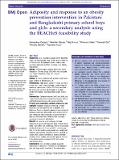Files in this item
Adiposity and response to an obesity prevention intervention in Pakistani and Bangladeshi primary school boys and girls : a secondary analysis using the BEACHeS feasibility study
Item metadata
| dc.contributor.author | Cezard, Geneviève | |
| dc.contributor.author | Bansal, Narinder | |
| dc.contributor.author | Bhopal, Raj | |
| dc.contributor.author | Pallan, Miranda | |
| dc.contributor.author | Gill, Paramjit | |
| dc.contributor.author | Barrett, Timothy | |
| dc.contributor.author | Adab, Peymane | |
| dc.date.accessioned | 2017-05-15T15:30:14Z | |
| dc.date.available | 2017-05-15T15:30:14Z | |
| dc.date.issued | 2016-02-09 | |
| dc.identifier | 249995216 | |
| dc.identifier | d1f474bd-4ee2-4e9a-845f-8f028c1fcf41 | |
| dc.identifier | 84960344421 | |
| dc.identifier.citation | Cezard , G , Bansal , N , Bhopal , R , Pallan , M , Gill , P , Barrett , T & Adab , P 2016 , ' Adiposity and response to an obesity prevention intervention in Pakistani and Bangladeshi primary school boys and girls : a secondary analysis using the BEACHeS feasibility study ' , BMJ Open , vol. 6 , no. 2 , e007907 . https://doi.org/10.1136/bmjopen-2015-007907 | en |
| dc.identifier.issn | 2044-6055 | |
| dc.identifier.other | RIS: urn:C2AAC1E88A5585A6F70C1B4A35FCF113 | |
| dc.identifier.other | ORCID: /0000-0002-3011-7416/work/60196727 | |
| dc.identifier.uri | https://hdl.handle.net/10023/10777 | |
| dc.description | The Birmingham healthy Eating, Active lifestyle for Children Study (BEACHeS) was funded by the National Prevention Research Initiative (NPRI), Grant no. G0501292. | en |
| dc.description.abstract | Objectives: As a secondary analysis of the BEACHeS study, we hypothesised there would be sex differences in Pakistani and Bangladeshi school children when examining adiposity and their response to an obesity intervention. Design: The Birmingham healthy Eating and Active lifestyle for CHildren Study (BEACHeS) was designed as a Phase II feasibility study of a complex intervention. Setting: 8 primary schools with predominantly South Asian children in Birmingham, UK. Participants: 1090 pupils (aged 5-7 years old) from school year 1 and 2 were allocated at school level to receive an intervention. A total of 574 were enrolled in the study with consent. We focused on the 466 children of Pakistani and Bangladeshi origin (50.6% boys). Intervention: Delivered between 2007 and 2009, the 1-year obesity prevention intervention targeted school and family-based dietary and physical activities. Primary and secondary outcome measures and analysis: Adiposity measures including skinfold thickness were compared by sex at baseline and follow-up. Gains in adiposity measures were compared between control and intervention arms in boys and in girls. Measures were compared using two-sample t tests and Wilcoxon-Mann-Whitney rank sum tests according to normality distribution. Results At baseline, girls had larger skinfold measures at all sites compared to boys although body mass index (BMI) was similar (eg, median subscapular skinfold 6.6 mm vs 5.7 mm; p<0.001). At follow-up, girls in the intervention group gained less weight and adiposity compared to respective controls (p<0.05 for weight, BMI, waist circumference, central and thigh skinfold) with a median total skinfold gain of 7.0?mm in the control group compared to 0.3 mm in the intervention group. Conclusions: Our secondary analysis suggests differences in adiposity in Pakistani and Bangladeshi girls and boys and in the effect of the intervention reducing adiposity in girls. These preliminary findings indicate that including sex differences should be examined in future trials. | |
| dc.format.extent | 9 | |
| dc.format.extent | 1060371 | |
| dc.language.iso | eng | |
| dc.relation.ispartof | BMJ Open | en |
| dc.subject | RA0421 Public health. Hygiene. Preventive Medicine | en |
| dc.subject | RJ101 Child Health. Child health services | en |
| dc.subject | NDAS | en |
| dc.subject | SDG 3 - Good Health and Well-being | en |
| dc.subject.lcc | RA0421 | en |
| dc.subject.lcc | RJ101 | en |
| dc.title | Adiposity and response to an obesity prevention intervention in Pakistani and Bangladeshi primary school boys and girls : a secondary analysis using the BEACHeS feasibility study | en |
| dc.type | Journal article | en |
| dc.contributor.institution | University of St Andrews. Geography & Sustainable Development | en |
| dc.identifier.doi | 10.1136/bmjopen-2015-007907 | |
| dc.description.status | Peer reviewed | en |
This item appears in the following Collection(s)
Items in the St Andrews Research Repository are protected by copyright, with all rights reserved, unless otherwise indicated.

